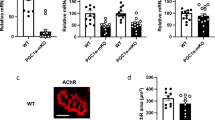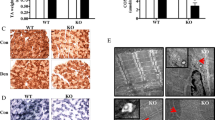Abstract
In skeletal muscle, slow-twitch fibers are highly dependent on mitochondrial oxidative metabolism suggesting the existence of common regulatory pathways in the control of slow muscle-specific protein expression and mitochondrial biogenesis. In this study, we determined whether peroxisome proliferator-activated receptor γ co-activator-1α (PGC-1α) could transactivate promoters of nuclear-encoded mitochondrial protein (cytochrome c) and muscle-specific proteins (fast troponin I, MyoD). We also investigated if calcineurin A (CnA) and calcium/calmodulin kinase IV (CaMKIV) were involved in the regulation of PGC-1α and cytochrome c promoter. For this purpose, we took advantage of the gene electrotransfer technique, which allows acute expression of a gene of interest. Electrotransfer of a PGC-1α expression vector into rat Tibialis anterior muscle induced a strong transactivation of cytochrome c promoter (P < 0.001) independent of nuclear respiratory factor 1. PGC-1α gene electrotransfer did not transactivate fast troponin I promoter, whereas it did transactivate MyoD promoter (P < 0.05). Finally, whereas electrotransfers of CnA or CaMKIV expression vectors transactivated PGC-1α promoter (P < 0.001), gene electrotransfer of CaMKIV was only able to transactivate cytochrome c promoter. Taken together, these data suggest that CnA triggers PGC-1α promoter transactivation to drive the expression of non-mitochondrial proteins.





Similar content being viewed by others
References
Akimoto T, Ribar TJ, Williams RS, Yan Z (2004) Skeletal muscle adaptation in response to voluntary running in Ca2+/calmodulin-dependent protein kinase IV-deficient mice. Am J Physiol Cell Physiol 287:C1311–C1319
Alway SE, Degens H, Krishnamurthy G, Smith CA (2002) Potential role for Id myogenic repressors in apoptosis and attenuation of hypertrophy in muscles of aged rats. Am J Physiol Cell Physiol 283:C66–C76
Andersson U, Scarpulla RC (2001) Pgc-1-related coactivator, a novel, serum-inducible coactivator of nuclear respiratory factor 1-dependent transcription in mammalian cells. Mol Cell Biol 21:3738–3749
Bigard X, Sanchez H, Zoll J, Mateo P, Rousseau V, Veksler V, Ventura-Clapier R (2000) Calcineurin co-regulates contractile and metabolic components of slow muscle phenotype. J Biol Chem 275:19653–19660
Calvo S, Stauffer J, Nakayama M, Buonanno A (1996) Transcriptional control of muscle plasticity: differential regulation of troponin I genes by electrical activity. Dev Genet 19:169–181
Chang JH, Lin KH, Shih CH, Chang YJ, Chi HC, Chen SL (2006) Myogenic basic helix-loop-helix proteins regulate the expression of peroxisomal proliferator activated receptor-gamma coactivator-1alpha. Endocrinology 147:3093–3106
Chin ER, Olson EN, Richardson JA, Yang Q, Humphries C, Shelton JM, Wu H, Zhu W, Bassel-Duby R, Williams RS (1998) A calcineurin-dependent transcriptional pathway controls skeletal muscle fiber type. Genes Dev 12:2499–2509
Daitoku H, Yamagata K, Matsuzaki H, Hatta M, Fukamizu A (2003) Regulation of PGC-1 promoter activity by protein kinase B and the forkhead transcription factor FKHR. Diabetes 52:642–649
Durieux AC, Bonnefoy R, Busso T, Freyssenet D (2004) In vivo gene electrotransfer into skeletal muscle: effects of plasmid DNA on the occurrence and extent of muscle damage. J Gene Med 6:809–816
Durieux AC, Bonnefoy R, Manissolle C, Freyssenet D (2002) High-efficiency gene electrotransfer into skeletal muscle: description and physiological applicability of a new pulse generator. Biochem Biophys Res Commun 296:443–450
Evans MJ, Scarpulla RC (1988) Both upstream and intron sequence elements are required for elevated expression of the rat somatic cytochrome c gene in COS-1 cells. Mol Cell Biol 8:35–41
Evans MJ, Scarpulla RC (1989) Interaction of nuclear factors with multiple sites in the somatic cytochrome c promoter. Characterization of upstream NRF-1, ATF, and intron Sp1 recognition sequences. J Biol Chem 264:14361–14368
Falkenberg M, Gaspari M, Rantanen A, Trifunovic A, Larsson NG, Gustafsson CM (2002) Mitochondrial transcription factors B1 and B2 activate transcription of human mtDNA. Nat Genet 31:289–294
Fisher RP, Clayton DA (1985) A transcription factor required for promoter recognition by human mitochondrial RNA polymerase. Accurate initiation at the heavy- and light-strand promoters dissected and reconstituted in vitro. J Biol Chem 260:11330–11338
Fisher RP, Clayton DA (1988) Purification and characterization of human mitochondrial transcription factor 1. Mol Cell Biol 8:3496–3509
Freyssenet D, Di Carlo M, Hood DA (1999) Calcium-dependent regulation of cytochrome c gene expression in skeletal muscle cells. Identification of a protein kinase c-dependent pathway. J Biol Chem 274:9305–9311
Freyssenet D, Irrcher I, Connor MK, Di Carlo M, Hood DA (2004) Calcium-regulated changes in mitochondrial phenotype in skeletal muscle cells. Am J Physiol Cell Physiol 286:C1053–C1061
Garcia-Roves PM, Huss J, Holloszy JO (2006) Role of calcineurin in exercise-induced mitochondrial biogenesis. Am J Physiol Endocrinol Metab 290:E1172–E1179
Gopalakrishnan L, Scarpulla RC (1994) Differential regulation of respiratory chain subunits by a CREB-dependent signal transduction pathway. Role of cyclic AMP in cytochrome c and COXIV gene expression. J Biol Chem 269:105–113
Gugneja S, Virbasius CM, Scarpulla RC (1996) Nuclear respiratory factors 1 and 2 utilize similar glutamine-containing clusters of hydrophobic residues to activate transcription. Mol Cell Biol 16:5708–5716
Handschin C, Rhee J, Lin J, Tarr PT, Spiegelman BM (2003) An autoregulatory loop controls peroxisome proliferator-activated receptor gamma coactivator 1alpha expression in muscle. Proc Natl Acad Sci USA 100:7111–7116
Herzig RP, Scacco S, Scarpulla RC (2000) Sequential serum-dependent activation of CREB and NRF-1 leads to enhanced mitochondrial respiration through the induction of cytochrome c. J Biol Chem 275:13134–13141
Herzog B, Cardenas J, Hall RK, Villena JA, Budge PJ, Giguere V, Granner DK, Kralli A (2006) Estrogen-related receptor alpha is a repressor of phosphoenolpyruvate carboxykinase gene transcription. J Biol Chem 281:99–106
Hunter JG, van Delft MF, Rachubinski RA, Capone JP (2001) Peroxisome proliferator-activated receptor gamma ligands differentially modulate muscle cell differentiation and MyoD gene expression via peroxisome proliferator-activated receptor gamma-dependent and -independent pathways. J Biol Chem 276:38297–38306
Huss JM, Kopp RP, Kelly DP (2002) Peroxisome proliferator-activated receptor coactivator-1alpha (PGC-1alpha) coactivates the cardiac-enriched nuclear receptors estrogen-related receptor-alpha and -gamma. Identification of novel leucine-rich interaction motif within PGC-1alpha. J Biol Chem 277:40265–40274
Huss JM, Torra IP, Staels B, Giguere V, Kelly DP (2004) Estrogen-related receptor alpha directs peroxisome proliferator-activated receptor alpha signaling in the transcriptional control of energy metabolism in cardiac and skeletal muscle. Mol Cell Biol 24:9079–9091
Johnson SE, Wang X, Hardy S, Taparowsky EJ, Konieczny SF (1996) Casein kinase II increases the transcriptional activities of MRF4 and MyoD independently of their direct phosphorylation. Mol Cell Biol 16:1604–1613
Kelly DP, Scarpulla RC (2004) Transcriptional regulatory circuits controlling mitochondrial biogenesis and function. Genes Dev 18:357–368
Kraus B, Pette D (1997) Quantification of MyoD, myogenin, MRF4 and Id-1 by reverse-transcriptase polymerase chain reaction in rat muscles—effects of hypothyroidism and chronic low-frequency stimulation. Eur J Biochem 247:98–106
Kubis HP, Haller EA, Wetzel P, Gros G (1997) Adult fast myosin pattern and Ca2+-induced slow myosin pattern in primary skeletal muscle culture. Proc Natl Acad Sci USA 94:4205–4210
Lin J, Wu H, Tarr PT, Zhang CY, Wu Z, Boss O, Michael LF, Puigserver P, Isotani E, Olson EN, Lowell BB, Bassel-Duby R, Spiegelman BM (2002) Transcriptional co-activator PGC-1 alpha drives the formation of slow-twitch muscle fibres. Nature 418:797–801
Meier JL, Stinski MF (1996) Regulation of human cytomegalovirus immediate-early gene expression. Intervirology 39:331–342
Meissner JD, Gros G, Scheibe RJ, Scholz M, Kubis HP (2001) Calcineurin regulates slow myosin, but not fast myosin or metabolic enzymes, during fast-to-slow transformation in rabbit skeletal muscle cell culture. J Physiol 533:215–226
Mootha VK, Handschin C, Arlow D, Xie X, St Pierre J, Sihag S, Yang W, Altshuler D, Puigserver P, Patterson N, Willy PJ, Schulman IG, Heyman RA, Lander ES, Spiegelman BM (2004) Erralpha and Gabpa/b specify PGC-1alpha-dependent oxidative phosphorylation gene expression that is altered in diabetic muscle. Proc Natl Acad Sci USA 101:6570–6575
Nakayama M, Stauffer J, Cheng J, Banerjee-Basu S, Wawrousek E, Buonanno A (1996) Common core sequences are found in skeletal muscle slow- and fast-fiber-type-specific regulatory elements. Mol Cell Biol 16:2408–2417
Ojuka EO, Jones TE, Han DH, Chen M, Holloszy JO (2003) Raising Ca2+ in L6 myotubes mimics effects of exercise on mitochondrial biogenesis in muscle. FASEB J 17:675–681
Ojuka EO, Jones TE, Han DH, Chen M, Wamhoff BR, Sturek M, Holloszy JO (2002) Intermittent increases in cytosolic Ca2+ stimulate mitochondrial biogenesis in muscle cells. Am J Physiol Endocrinol Metab 283:E1040–E1045
Passier R, Zeng H, Frey N, Naya FJ, Nicol RL, McKinsey TA, Overbeek P, Richardson JA, Grant SR, Olson EN (2000) CaM kinase signaling induces cardiac hypertrophy and activates the MEF2 transcription factor in vivo. J Clin Invest 105:1395–1406
Rose AJ, Kiens B, Richter EA (2006) Ca2+–calmodulin-dependent protein kinase expression and signalling in skeletal muscle during exercise. J Physiol 574:889–903
Ryder JW, Bassel-Duby R, Olson EN, Zierath JR (2003) Skeletal muscle reprogramming by activation of calcineurin improves insulin action on metabolic pathways. J Biol Chem 278:44298–44304
Scarpulla RC (2006) Nuclear control of respiratory gene expression in mammalian cells. J Cell Biochem 97:673–683
Schreiber SN, Emter R, Hock MB, Knutti D, Cardenas J, Podvinec M, Oakeley EJ, Kralli A (2004) The estrogen-related receptor alpha (ERRalpha) functions in PPARgamma coactivator 1alpha (PGC-1alpha)-induced mitochondrial biogenesis. Proc Natl Acad Sci USA 101:6472–6477
Schreiber SN, Knutti D, Brogli K, Uhlmann T, Kralli A (2003) The transcriptional coactivator PGC-1 regulates the expression and activity of the orphan nuclear receptor estrogen-related receptor alpha (ERRalpha). J Biol Chem 278:9013–9018
St-Pierre J, Lin J, Krauss S, Tarr PT, Yang R, Newgard CB, Spiegelman BM (2003) Bioenergetic analysis of peroxisome proliferator-activated receptor gamma coactivators 1alpha and 1beta (PGC-1alpha and PGC-1beta) in muscle cells. J Biol Chem 278:26597–26603
Vega RB, Huss JM, Kelly DP (2000) The coactivator PGC-1 cooperates with peroxisome proliferator-activated receptor alpha in transcriptional control of nuclear genes encoding mitochondrial fatty acid oxidation enzymes. Mol Cell Biol 20:1868–1876
Virbasius CA, Virbasius JV, Scarpulla RC (1993) NRF-1, an activator involved in nuclear-mitochondrial interactions, utilizes a new DNA-binding domain conserved in a family of developmental regulators. Genes Dev 7:2431–2445
World Medical Association, American Physiological Society (2002) Guiding principles for research involving animals and human beings. Am J Physiol Regul Integr Comp Physiol 283:R281–R283
Wu H, Kanatous SB, Thurmond FA, Gallardo T, Isotani E, Bassel-Duby R, Williams RS (2002) Regulation of mitochondrial biogenesis in skeletal muscle by CaMK. Science 296:349–352
Wu Z, Huang X, Feng Y, Handschin C, Feng Y, Gullicksen PS, Bare O, Labow M, Spiegelman B, Stevenson SC (2006) Transducer of regulated CREB-binding proteins (TORCs) induce PGC-1alpha transcription and mitochondrial biogenesis in muscle cells. Proc Natl Acad Sci USA 103:14379–14384
Wu Z, Puigserver P, Andersson U, Zhang C, Adelmant G, Mootha V, Troy A, Cinti S, Lowell B, Scarpulla RC, Spiegelman BM (1999) Mechanisms controlling mitochondrial biogenesis and respiration through the thermogenic coactivator PGC-1. Cell 98:115–124
Zong H, Ren JM, Young LH, Pypaert M, Mu J, Birnbaum MJ, Shulman GI (2002) AMP kinase is required for mitochondrial biogenesis in skeletal muscle in response to chronic energy deprivation. Proc Natl Acad Sci USA 99:15983–15987
Acknowledgements
The authors gratefully acknowledge S. Konieczny (Department of Biological Sciences, Purdue University, IN, USA) for donating the TnI and MyoD promoter reporter plasmids, E. Olson (University of Texas, Dallas, TX, USA) for donating the CnA and CaMKIV expression vectors, R. Scarpulla (Northwestern University Medical School, IL, USA) for donating the cytochrome c promoter reporter plasmids and NRF-1 expression vector and B. Spiegelman (Harvard Medical School, Boston, MA, USA) for donating the PGC-1α expression vector.
Author information
Authors and Affiliations
Corresponding author
Rights and permissions
About this article
Cite this article
Guerfali, I., Manissolle, C., Durieux, AC. et al. Calcineurin A and CaMKIV transactivate PGC-1α promoter, but differentially regulate cytochrome c promoter in rat skeletal muscle. Pflugers Arch - Eur J Physiol 454, 297–305 (2007). https://doi.org/10.1007/s00424-007-0206-6
Received:
Revised:
Accepted:
Published:
Issue Date:
DOI: https://doi.org/10.1007/s00424-007-0206-6




